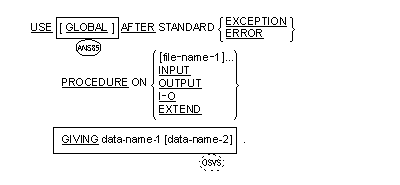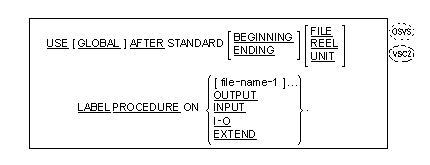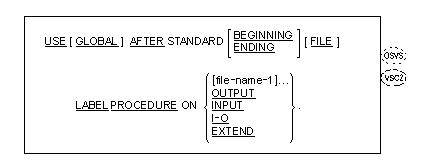The USE statement specifies procedures for input-output error handling, that are in addition to the standard procedures provided by the input-output control system.
General Formats for Format 1 (Sequential , Relative and Indexed Files)



General Formats for Format 2 (Record Sequential Files)



General Formats for Format 3 (Relative and Indexed Files)

Syntax Rules for All Formats (All Files)
- Format 1 is the ERROR declarative.

 Formats 2 and 3 are the LABEL declarative.
Formats 2 and 3 are the LABEL declarative.
- A USE statement, when present, must immediately follow a section header in the Declaratives Section and must be followed by a period followed by a space.
- The USE statement itself is never executed; it merely defines the conditions calling for the execution of the USE procedures.
- The files implicitly or explicitly referenced in a USE statement need not all have the same organization or access.
Syntax Rules for Format 1 (Sequential, Relativeand Indexed Files)
- The same file-name can appear in a different specific arrangement of the format. Appearance of a file-name in a USE statement must not cause the simultaneous request for execution of more than one USE procedure.
 The same file-name must not appear in more than one USE AFTER EXCEPTION statement within the same Procedure Division.
The same file-name must not appear in more than one USE AFTER EXCEPTION statement within the same Procedure Division.
- The words ERROR and EXCEPTION are equivalent and can be used interchangeably.


Syntax Rules for Formats 2 and 3 (Record Sequential,Relative and Indexed Files)

 If both BEGINNING and ENDING are omitted, the effect is as though both BEGINNING and ENDING had been specified.
If both BEGINNING and ENDING are omitted, the effect is as though both BEGINNING and ENDING had been specified.


Syntax Rules for Format 2 (Record Sequential Files)

 REEL and UNIT are treated as equivalent.
REEL and UNIT are treated as equivalent.

 If both FILE and REEL/UNIT are omitted, the effect is as though both REEL or UNIT and FILE had been specified.
If both FILE and REEL/UNIT are omitted, the effect is as though both REEL or UNIT and FILE had been specified.

 Any one file-name and any one OPEN mode can appear in only one declarative for each of the possible combinations of BEGINNING/ENDING and FILE/REEL as shown below:
Any one file-name and any one OPEN mode can appear in only one declarative for each of the possible combinations of BEGINNING/ENDING and FILE/REEL as shown below:
- BEGINNING FILE
- BEGINNING REEL/UNIT
- ENDING FILE
- ENDING REEL/UNIT
General Rules for Format 1 (Sequential,Relative and Indexed Files)
- The designated procedures are executed by the input-output system after completing the standard input-output error routine, or upon recognition of the AT END condition, when the AT END phrase has not been specified in the input-output statement.
 When file-name-1 is specified explicitly, no other USE statement applies to file-name-1.
When file-name-1 is specified explicitly, no other USE statement applies to file-name-1.
- The GIVING phrase is documentary only.


General Rules for Formats 2 and 3 (Record Sequential,Relative and Indexed Files)

 If the BEGINNING phrase is specified explicitly or implicitly, the following actions are taken during the execution of an applicable OPEN statement:
If the BEGINNING phrase is specified explicitly or implicitly, the following actions are taken during the execution of an applicable OPEN statement:
| Open Mode
|
Action
|
| INPUT
|
- Read header labels
- Execute beginning declarative
|
| OUTPUT
|
- Execute beginning declarative
- Write header labels
|
| I/O
|
- Read header labels
- Execute beginning declarative
- Write header labels
|
| EXTEND
|
- Read header labels
- Execute beginning declaratives (trailer labels treated as header)
- Write header labels
|

 If the ENDING phrase is specified explicitly or implicitly, the following actions are taken during the execution of an applicable CLOSE statement:
If the ENDING phrase is specified explicitly or implicitly, the following actions are taken during the execution of an applicable CLOSE statement:
| Open Mode
|
Action
|
| INPUT
|
- Read trailer labels
- Execute ending declarative
|
| OUTPUT
|
- Execute ending declarative
- Write trailer labels
|
| I/O
|
- Read trailer labels
- Execute ending declarative
- Write trailer labels
|
| EXTEND
|
- Execute ending declaratives
- Write trailer labels
|

 The statement GO TO MORE-LABELS appearing in a declarative procedure is treated as a simple jump to the start of the declarative procedure in which it appears.
The statement GO TO MORE-LABELS appearing in a declarative procedure is treated as a simple jump to the start of the declarative procedure in which it appears.






![]()
![]() Formats 2 and 3 are the LABEL declarative.
Formats 2 and 3 are the LABEL declarative.
![]() The same file-name must not appear in more than one USE AFTER EXCEPTION statement within the same Procedure Division.
The same file-name must not appear in more than one USE AFTER EXCEPTION statement within the same Procedure Division.
![]()
![]()
![]() This restriction can be ignored.
This restriction can be ignored.


